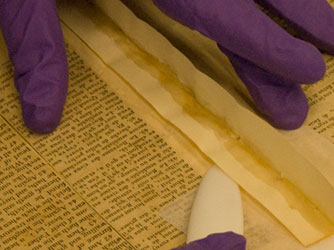
Conservation
Time and use caused Jefferson's volume to
become so fragile that the museum could no
longer make it available to researchers or the
public. Because the adhesive Jefferson used to
glue the clippings caused the paper to become
stiff and inflexible, the pages cracked and tore
as the book's equally inflexible binding was
opened. The goal of the conservation project
was to physically and chemically stabilize the
book and make it accessible once again.
Jefferson's book presented complex conservation problems. It contains
twelve different types of paper, six printing inks, four manuscript inks, two
adhesives, linen thread, silk thread and goatskin leather. A team of conservators
conducted materials analysis, assessed the benefit versus risk of potential
treatment options, and established documentation of the materials' current
condition for future comparison.
To repair the artifact, the cover was removed
intact. Jefferson's pages were physically
stabilized with conservation repair tissue and
reversible adhesives. High-resolution digital
images were captured to ensure public access.
The pages were rebound in the historic cover
in a manner sympathetic to the original, but
with slight modifications to prevent the same
damage from recurring.
In addition to the generous support of our donors, the exhibition and
conservation received assistance from several departments across the
Institution. They include the National Museum of the American Indian,
the Museum Conservation Institute, Smithsonian Institution Archives,
and Smithsonian Institution Libraries.
6 of 6
